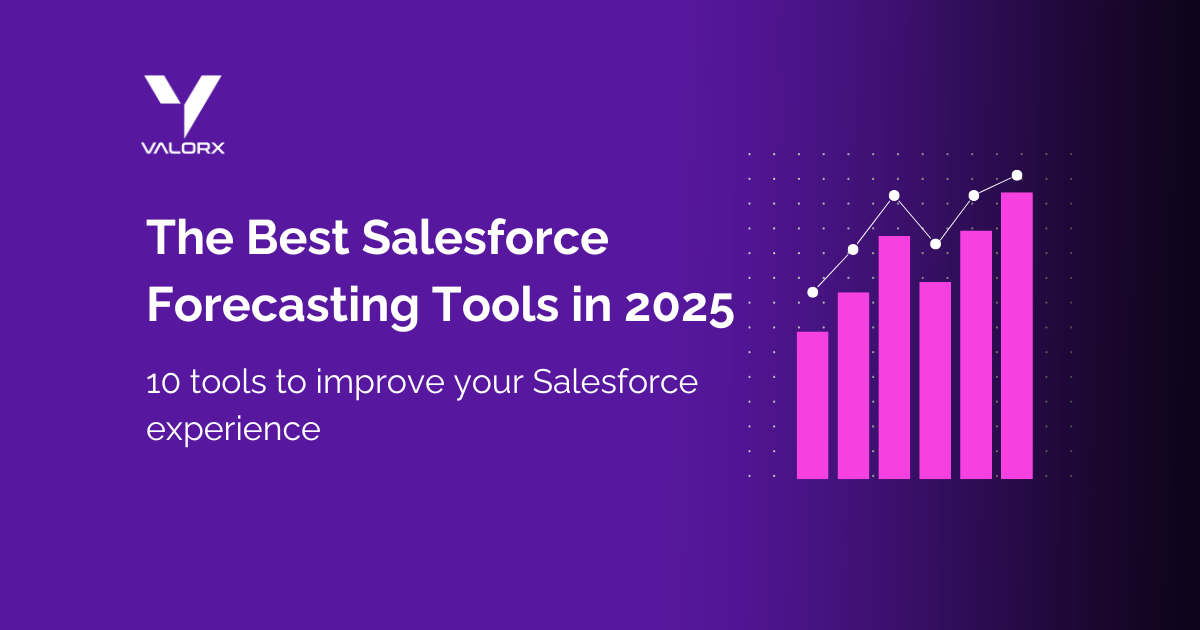When planning for your business (whether for manufacturing or sales performance), choosing the right Salesforce forecasting tool can make a significant difference. In today’s market there are a number of advanced tools with sophisticated capabilities that help you best leverage your Salesforce data to drive business and keep costs low.
In this post, we take a look at the notable capabilities and limitations of 10 different forecasting tools available to Salesforce users today.
1. Valorx Fusion
Overview: Fusion combines Excel functionality and high performance with Salesforce, allowing users to manage forecasts, bulk edit records (hundreds or thousands at a time), and handle complex data models, particularly for manufacturing forecasting and complex quoting (CPQ).
Key Features: Real-time data syncing, Excel functionality and calculations, real-time forecast management, data visualization, and high-volume data processing.
Unlike other Excel-Salesforce connectors, it syncs data in real time, it allows you to preview changes first, and also tracks changes and allows users to revert changes. With Excel as the interface, the entire range of capabilities(bulk editing, conditional formatting, sorting/filtering, formulas, macros, etc.) can be used to work with Salesforce data. It is also far easier/faster to model different scenarios to compare outcomes and improve decision making. The Fusion engine allows for a highly-responsive user experience that overcomes the performance limitations of native Salesforce.
It also allows for completely customizable multi-measure views (where you can bulk update your data) and time-period toggling (which lets you view the same forecast in different time periods with a click). This allows manufacturers to handle the distinct forecasting needs of their business and industry.
Limitations: Fusion is not an out-of-the-box solution - it requires some technical configuration due to the complexity it is meant to handle. In the case of limited resourcing or time, the Valorx professional services team can be engaged to assess a business’ forecasting needs and set up Fusion, if the in-house support is limited.
2. Valorx Wave
Overview: Valorx Wave is a productivity solution that offers a spreadsheet-like interface as the front end for Salesforce and allows its users to work with Salesforce data more efficiently. With Wave, users can perform bulk edits, apply conditional formatting, and edit data from reports directly within Salesforce.
Key Features: With Wave, Salesforce users can analyze forecasts across various time frames—yearly, quarterly, monthly, weekly, and even daily—for a comprehensive view of sales or manufacturing projections. The spreadsheet-like interface allows for intuitive visualization of data. Features such as conditional formatting and grouping enhance the clarity and interpretability of complex datasets. Salesforce users can also create reports that encompass multiple Salesforce objects within a single view, offering a holistic perspective essential for accurate forecasting and planning. Wave is available for the browser (Google Chrome, Microsoft Edge) and embedded directly in Salesforce.
Limitations: While Valorx Wave excels in streamlining data management, it can face challenges when handling intricate data models that require advanced forecasting algorithms or extensive customization. As well, users with highly-specific forecasting requirements might find the need for additional customization beyond the standard capabilities of Valorx Wave.
For such scenarios, integrating with more specialized tools or utilizing Valorx's Fusion product might be necessary.
3. Salesforce Manufacturing Cloud
Overview: Built by Salesforce, this product helps manufacturers align sales and operations planning to improve production and financial forecasting.
Key Features: Manufacturing Cloud allows for account-based forecasting, unified sales and operations data, and improved forecasting accuracy. It streamlines the flow of data from customer agreements to demand forecasts and then production schedules, enhancing coordination across teams. With AI-driven insights, manufacturers optimize inventory, anticipate demand, and improve delivery accuracy for stronger customer relationships and profitability.
Limitations: While helpful, getting started has its challenges. Users have noted that implementation can be complex/lengthy, and may require significant customization for unique manufacturing needs. Due to its unique interface, it can also require extensive training for users unfamiliar with the solution’s features. These initial limitations can be overcome with a number of tools available on the Salesforce AppExchange, all designed to improve the platform’s out-of-the-box UI.
3. Einstein Analytics (Tableau CRM)
Overview: Offers advanced analytics and forecasting features powered by AI, with prebuilt dashboards for sales teams to predict revenue and spot at-risk deals.
Key Features: Einstein Analytics includes predictive analytics, AI-driven insights, and customizable dashboards. A helpful option for crunching high data volumes and understanding trends.
Limitations: Without deep analytics expertise, some users may find the AI predictions difficult to interpret. It has a steep learning curve. The solution can experience slower performance when working with high-volume datasets. It may also be cost prohibitive to smaller businesses.
4. Clari
Overview: Improves sales forecasting accuracy by analyzing sales pipeline data and offering predictive insights.
Key Features: AI-powered forecasting, pipeline visibility, and real-time updates to Salesforce. Clari’s predictive AI can help provide more precise sales projections, identify risks, and address gaps. It can assign health scores for specific opportunities, optimizing efforts for the right accounts. It also supports scenario modeling tocompare outcomes and enable proactive decision making.
Limitations: For some, Clari’s interface lacks much-needed customization options. It may not always integrate smoothly with customized Salesforce instances, requiring additional configurations and effort to maintain.
5. Revenue Grid
Overview: A revenue intelligence platform that tracks sales pipeline performance and provides AI-driven forecasting for Salesforce.
Key Features: Automated forecasting, AI insights, and pipeline visibility. Revenue Grid is able to automatically gather a range of data across multiple sources to bolster its sales forecasts without requiring manual effort. It provides insights that diagnose and pinpoint changes in forecasts to help teams take actions to meet sales quotas. It also allows users to visualize pipelines in a helpful way, to analyze and understand data.
Limitations: Users may experience delays or inaccuracies in data syncing between Revenue Grid and Salesforce. For some, the user interface is also not considered intuitive/friendly and presents a steep learning curve.
6. InsightSquared
Overview: Provides advanced sales analytics and forecasting solutions, helping sales leaders with pipeline management and accurate forecasts.
Key Features: AI-powered forecasting, pipeline management, and revenue optimization. Its pipeline management tools provide real-time visibility into sales activities, helping teams identify opportunities and risks within the sales process. Additionally, InsightSquared's revenue optimization features analyze performance metrics to uncover areas for improvement, facilitating strategies that drive growth and efficiency.
Limitations: There may be occasional discrepancies between InsightSquared forecasts and Salesforce data. The platform is also considered expensive for smaller businesses.
7. Adaptive Insights by Workday
Overview: A financial planning and forecasting solution that integrates with Salesforce to improve sales and revenue forecasts.
Key Features: Flexible scenario planning, real-time collaboration, data visualization. Adaptive Insights allows for rapid modeling of various business scenarios to assess potential outcomes and inform strategic decisions. It facilitates real-time collaboration by allowing simultaneous input from multiple stakeholders on forecasts, ensuring alignment and accelerating the planning process. Additionally, its data visualization provides intuitive dashboards and charts for clear insights, enhancing analysis and reporting.
Limitations: The tool is considered difficult to set up and configure, requiring technical expertise and IT involvement. It also encounters slow performance when processing large datasets or complex forecasts.
8. Aviso
Overview: Provides AI-based forecasting and sales visibility solutions for Salesforce users.
Key Features: AI-driven forecasts, deal health analysis, and real-time forecast editing. Its deal health analysis evaluates opportunities, identifying risks and suggesting next steps. Real-time forecast adjustments allow dynamic scenario planning, enabling sales teams to adapt strategies promptly.
Limitations: It can be difficult to understand how the AI predictions are generated, which throws into question the accuracy/value of the sales projections it generates. Customization limitations for reports and dashboards make it less suitable for businesses with specific needs.
9. People.ai
Overview: Uses AI to enhance forecasting by analyzing sales activity and pipeline data within Salesforce.
Key Features: AI-powered insights, activity tracking, pipeline analysis, and predictive forecasting. Its AI engine analyzes a wide range of data including sales activities (emails, meetings, calls, and other interactions), CRM data, and proprietary buyer profile data to present users with sales forecasts, potential risks to deals, and actions to take to drive sales.
Known Limitations/Complaints: Some users report that People.ai’s AI occasionally makes predictions based on incomplete or outdated data.Some users mention that integrating People.ai into their existing Salesforce setup can be challenging, especially in highly customized environments.
10. Anaplan for Salesforce
Overview: A connected planning platform that integrates with Salesforce to enhance financial, sales, and operations forecasting.
Key Features: Collaborative forecasting, scenario planning, and real-time insights. Anaplan enhances forecasting through collaborative tools that unify data and teams, enabling synchronized planning across departments. Its scenario planning allows users to model various business situations, assessing potential outcomes to inform strategic decisions. Additionally, Anaplan provides real-time insights by integrating internal and external data, offering up-to-date information for agile decision-making.
Limitations: The initial setup and integration with Salesforce demand significant time and technical resources, making it challenging for businesses with limited IT support or eager to ramp up productivity/scale quickly. Additionally, the platform's steep learning curve poses difficulties, particularly for users unfamiliar with advanced planning tools and requires substantial training and onboarding to leverage its full set of capabilities.
Choosing the forecasting tool for you
Selecting the ideal forecasting tool depends on your unique business needs, scale, and data complexity. Whether you're looking for deep AI-driven insights, seamless Excel integration, or real-time scenario planning, different tools bring different strengths to the table and empower your teams in unique ways. Equip your team with the right solution to enhance accuracy, streamline processes, and propel your forecasting capabilities into 2025 and beyond.
Interested in Valorx Fusion or Wave? Visit the product page to learn more:

